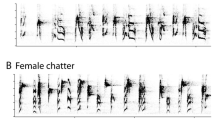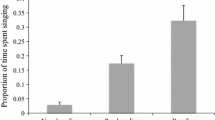Summary
Female Nuttall's White-crowned Sparrows (Zonotrichia leucophrys nuttalli) were tested in a laboratory experiment to determine their response to stimulation by songs from their natal dialect (Clear) and by songs from three different alien dialects (Fig. 1). The greatest number of copulation solicitation displays and amount of locomotor activity were caused by songs of the subject's natal dialect (Clear); the next most potent stimulus was the contiguously adjacent dialect (Buzzy); the least effective stimuli were songs from a dialect 25 km distant (McClure), representing the same non-migratory subspecies, and a dialect 1,900 km distant (Sand Creek), representing a migratory montane subspecies of White-crowned Sparrow (Figs. 2–4).
These results constitute a test of a deduction made from the assortative mating theory and suggest that female White-crowned Sparrows find male song of their natal dialect sexually more stimulating. Thus, speculating about the natural circumstances, females given an unrestricted choice would be expected to mate with males from their natal dialect region.
Similar content being viewed by others
References
Andrew RJ (1956) The aggressive and courtship behaviour of certain emberizines. Behaviour 10:255–308
Andrew RJ (1961) The displays given by passerines in courtship and reproductive fighting: a review. Behaviour 103a:315–348, 549–579
Baker MC (1975) Song dialects and genetic differences in White-crowned Sparrows (Zonotrichia leucophrys). Evolution 29:226–241
Baker MC, Mewaldt LR (1981) Response to “Song dialects as barriers to dispersal: a re-evaluation”. Evolution 35:189–190
Baker MC, Thompson DB, Sherman GL, Cunningham MA (1981) The role of male vs male interactions in maintaining population dialect structure. Behav Ecol Sociobiol 8:65–69
Baker MC, Spitler-Nabors KJ, Bradley DC (1982a) The response of female Mountain White-crowned Sparrows to songs from their natal dialect and an alien dialect. Behav Ecol Sociobiol 10:175–179
Baker MC, Thompson DB, Sherman GL, Cunningham MA, Tomback DF (1982b) Allozyme frequencies in a linear series of song dialect populations. Evolution 36:1020–1029
Baptista LF, Morton ML (1982) Song dialects and mate selection in Montane White-crowned Sparrows. Auk 99:537–547
Blanchard BD (1941) The White-crowned Sparrow (Zonotrichia leucophrys) of the Pacific seaboard: environment and annual cycle. Univ Calif Publ Zool 56:1–135
DeWolfe B (1968) Nuttall's White-crowned Sparrow. In: Austin OL (ed) Life histories of North American cardinals, grosbeaks, buntings, towhees, finches, sparrows, and allies, part III. Smithsonian Institute Press, Washington, DC, pp 1292–1324
Ficken MS (1963) Courtship of the American Redstart. Auk 80:307–317
Ficken RW (1963) Courtship and agonistic behavior of the Common Grackle, Quiscalus quiscula. Auk 80:52–72
Ficken MS, Ficken RW (1968) Courtship of Blue-winged Warblers, Golden-winged Warblers, and their hybrids. Wilson Bull 80:161–172
Hinde RA (19755–1956) A comparative study of the courtship of certain finches (Fringillidae). Wilson Bull 97:706–745; 98:1–23
Konishi M (1965) The role of auditory feedback in the control of vocalizations in the White-crowned Sparrow. Z Tierpsychol 22:770–783
Marler P (1956) Behaviour of the Chaffinch, Fringilla coelebs. Behaviour Suppl VI:1–186
Marler P, Tamura M (1962) Song “dialects” in three populations of White-crowned Sparrows. Condor 64:368–377
Milligan M, Verner J (1971) Inter-population song discrimination in the White-crowned Sparrow. Condor 73:208–213
Nottebohm F (1969) The song of the Chingolo, Zonotrichia capensis, in Argentina: description and evaluation of a system of dialects. Condor 71:299–315
Nottebohm F (1970) Ontogeny of bird song. Science 167:950–956
Petrinovich L, Patterson T, Baptista LF (1981) Song dialects as barriers to dispersal: a re-evaluation. Evolution 35:180–188
Searcy WA, Marler P (1981) A test for responsiveness to song structure and programming in female sparrows. Science 213:926–928
Siegel S (1956) Nonparametric statistics for the behavioral sciences. McGraw-Hill, New York
Sokal RR, Rohlf FJ (1969) Biometry. Freeman, San Francisco
Tomback DF, Thompson DB, Baker MC (1983) Dialect discrimination by White-crowned Sparrows: reactions to near and distant dialects. Auk (in press)
West MJ, King AP, Eastzer DH (1981) The cowbird: Reflections on development from an unlikely source. Am Sci 69:56–66
Author information
Authors and Affiliations
Rights and permissions
About this article
Cite this article
Baker, M.C. The behavioral response of female Nuttall's White-crowned Sparrows to male song of natal and alien dialects. Behav Ecol Sociobiol 12, 309–315 (1983). https://doi.org/10.1007/BF00302898
Received:
Accepted:
Issue Date:
DOI: https://doi.org/10.1007/BF00302898




